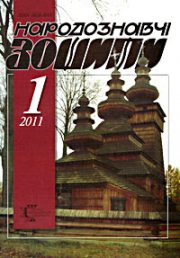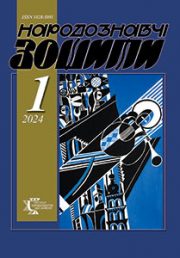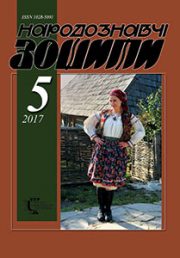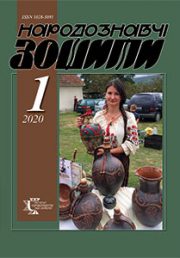The Ethnology Notebooks. 2024. № 3 (177), 596—604
UDK 94:[398.7:159.922/.923:159.963:159.953]
DOI https://doi.org/10.15407/nz2024.03.596
MODELING PROPERTIES OF DREAMS: VIRTUAL REALITY AND MYTHOLOGICAL CONTEXT
TEMCHENKO Andriy
- ORCID ID: http://orcid.org/0000-0003-3999-9459
- Candidate of Historical Sciences, Associate Professor,
- Associate Professor of the Department of the Ukrainian History
- of the Bohdan Khmelnytsky National University of Cherkasy,
- 81, boulevard of Shevchenko, 18000, Сherkasy, Ukraine,
- Contacts: e-mail: temchen@ukr.net
Abstract. Introduction. The article attempts to consider the modeling properties of dreams in the context of the myth as a system of mental stereotypes and mental attitudes.
The purpose of the publication is to identify specific features that allow one to consider dreams as an altered state of consciousness that not only reflects on external circumstances, but is capable of modeling its own cultural meanings.
The research methods are aimed at the analytical and synthetic understanding of the processes related to the myth and dream, which involves the involvement of the experience of other humanitarian fields, in particular, Philosophy, Psychology and Linguistics.
The obtained results. In contrast to the situation of «everyday life» in traditional culture, a dream can form the «agenda» of everyday activities, as it is able not only to «reboot» the operating system, which is used to process and adapt personal information, but in a certain way to «reprogram» its functionality.
As a result of this, new operational data are «loaded», other options are «configured», the system interface is updated, as a result of which constructive or destructive behavioral models can be built in the subconscious, which act automatically and are not controlled by consciousness. Most of all, this refers to archetypal dreams that create a corresponding emotional state, which is realized in spontaneous everyday actions. For example, a dream about unclean water is associated with illness, since dirt is a marker of infectious diseases. Physical impurity can be projected onto states associated with the expectation of troubles of a different nature.
The perception of a dream as a cause of everyday life is due to the specificity of human memory, which is able to record not only real but imaginary events. Memory capabilities allow one to arbitrarily «record» on the tape of the subconscious almost everything that falls into its field of vision — random sounds, fragments of reality, smells, touches, spontaneous emotions, as well as internal associations and suggestive impressions. As a result, a «personal» data bank of a specific person is formed, which is «used» by the subconscious to model endless modifications of dream plots and images. «Personal data» accumulated in this way can also be linked to a collective information base.
Keywords: binary opposition, dйjа vu, altered state of consciousness, myth, past, simulation, ritual, subconscious, memory, ritual, sacred, dream, time, time of creation.
Received 9.04.2024
REFERENCES
- Ludwig, A. (1966). Altered states of consciousness. Archives of general psychiatry, 15, 225—234.
- Blanke, O. & Dieguez, S. (2009). Leaving Body and Life Behind: Out-of-Body and Near-Death Experience. The Neurology of Consciousness (Pp. 303—325).
- Eliade, M., Bogutsky, S., & Trilis, S. (1998). Shamanism. Archaic Techniques of Ecstasy. Kyiv: Sofia[in Russian].
- Walch, R. (1990). The spirit of schamanism. Los Angeles: Jeremy P. Tarcher, Inc.
- Walter, Namba, M., & Fridman, Neumann Jane, Eva (Eds.). (2004). Biopsychosocial Perspective. What is a shaman? (Pp. 169—176). Santa Barbara; California; Denver; Colorado; Oxford; England: ABC CLIO [in German].
- Walter, Namba, M., & Fridman Neumann Jane, Eva (Eds.). (2004). «Black» Shaman, «White» Shamans (Pp. 536—539). Santa Barbara; California; Denver; Colorado; Oxford; England: ABC CLIO.
- Kucherenko, Ye,V. (2013). Altered States of Consciousness as an Object of Psychological Research. Bulletin of the Institute of Child Development. Series: Philosophy, Pedagogy, Psychology: Collection of Scientific Papers (Vol. 30, pp. 133—137). Kyiv: NPU named after M.P. Drahomanov [in Ukrainian].
- Bourguignon, E., & Hsu, F.L.K. (Ed.). (1972). Dreams and Altered States of Consciousness in Anthropological research. Psychological Anthropology (Pp. 403—434). Cambridge (Mass.).
- Temchenko, A. (2022). «Text» and «context» of a Dream (a Study of Traditional Culture). Materials for Ukrainian Ethnology, 21 (24), 64—73 [in Ukrainian].
- Brogaard, Berit, D.M. (2013). The Superhuman Mind. Remembering Things From Before You Were Born. Can memories be innate? Retrieved from: https://www.psychologytoday.com/intl/blog/the-superhuman-mind/201302/remembering-things-you-were-born (access date 29.06.2023).
- Bernstein, L.S. Egregor. (2023). Confraternity of the Rose CrossServing the ideals of the Rosicrucian Movement. Retrieved from: https://web.archive.org/web/20120108221129/http://www.crcsite.org/printegregor.htm (access date 15.05.2023).
- Temchenko, A.I. (2015). Traditional Mantic Practices: Archaic Sign System. Cherkasy: IntroligaTOR [in Ukrainian].
- Merkulov, I.P. (1999). Cognitive evolution. Retrieved from:https://platona.net/load/knigi_po_filosofii/kognitivnye_nauki/merkulov_i_p_kognitivnaja_ehvoljucija/17-1-0-2807 (access date 26.02.2022) [in Russian].
- Vertil, O. (2011, january 15). Memories of the future. Government Courier. Retrieved from: https://ukurier.gov.ua/uk/articles/spogadi-pro-majbutnye/ (access date 05.09.2023) [in Ukrainian].
- Memories of the Future. Black Square. Retrieved from: https://artkvadrat.com/performance/vospominaniyaobudushem (access date 22.03.2022) [in Ukrainian].
- Mahda, Ye. (2017). The Sixth. Memories of the Future. Kyiv: KDS [in Ukrainian].
- Von Daniken, E. (2004). Memories of the Future. Retrieved from: https://coollib.net/b/434950-erih-fon-deniken-vospominaniya-o-buduschem/read (access date 03.11.2023) [in Russian].
- Memories of the Future. Retrieved from: https://afishalviv.net/arh/spogadi-pro-majbutnye/ (access date 23.03.2022).
- Zarubytsky, K.Ye. (2014). «Memories of the Future» or Eternity as the Unity of Time. Scientific Bulletin of the National University of Bioresources and Nature Management of Ukraine. Series: Humanitarian Studies (Issue 203 (1), pp. 27—35). Retrieved from: http://nbuv.gov.ua/UJRN/nvnubgc_2014_203%281%29__6 (access date 22.09.2022) [in Ukrainian].
- Richard, M. (1995). Introduction to Fractals and Chaos. Crownover University of Missouri-Columbia Jones and Bartlett Publishers Boston London.
- Brown, A.S. (2004). The Deja Vu Experience. Psychology Press. Retrieved from: https://www.taylorfrancis.com/books/edit/10.4324/9780203485446/deja-vu-experience-alan-brown (access date 22.09.2022).
- Kurgan, A.A. (2010). Phenomenon of Dejа Vu. St. Petersburg: Dmitry Bulanin. Retrieved from: https://www.gumer.info/bogoslov_Buks/Philos/kurg/index.php (access date 22.09.2022) [in Russian].
- Zuger, B. (1966, june). The time of dreaming and the Dejа Vu. Comprehensive Psychiatry (Vol. 7, pp. 191—196).
- Chervynsky, P.P. (2010). Dictionary of Dream Interpretation. Notes on the Structure of the Interpretive Model. Ternopil: Krok [in Russian].
- Chudziсska-Parkosadze, A. (2014). Oneiric Motifs in Mikhail Bulgakov’s Novel «The Master and Margarita». Russian studies review, 3 (147), 77—92. Retrieved from: https://www.journals.us.edu.pl/index.php/PR/article/view/3435/2268 (access date 26.02.2022) [in Russian].
- Hellerstein, S.G. (2006). Can We Remember the Future? Cultural and Historical Psychology, 4 (Vol. 2). Retrieved from: https://psyjournals.ru/kip/2006/n4/Gellerstein.shtml (access date 26.02.2022) [in Russian].
- Smolin, L. (2004). Scientific alternatives to the anthropic principle. High Energy Physics — Theory. Retrieved from: https://web.archive.org/web/20200524023720/https://arxiv.org/abs/hep-th/0407213 (access date 26.02.2022).
- Chubynsky, P.P. (1995). Wisdom of the Ages. Ukrainian Folklore in the Creative Heritage of Pavlo Chubynsky: in 2 vol. (Vol. 1). Kyiv: Mystetstvo [in Ukrainian].
- Hrinchenko, B. (Ed.). (1907—1909). Dictionary of the Ukrainian Language: in 4 vol. (Vol. 3, p. 113). Kyiv. Retrieved from: http://ukrlit.org/slovnyk/hrinchenko_slovar_ukrainskoi_movy/%D0%BF%D0%B5%D1%80%D0%B5%D0%B3%D0%B5%D0%BD%D1%8F (access date 26.02.2024) [in Ukrainian].
- Temchenko, A. (2023). The Reality of the «Unreal»: Programming Functions of Dreams in the Magic of Suggestion (a Study of the Material of the Traditional Culture of Ukrainians). Ethnological Notebooks, 3 (171), 586—596 [in Ukrainian].







